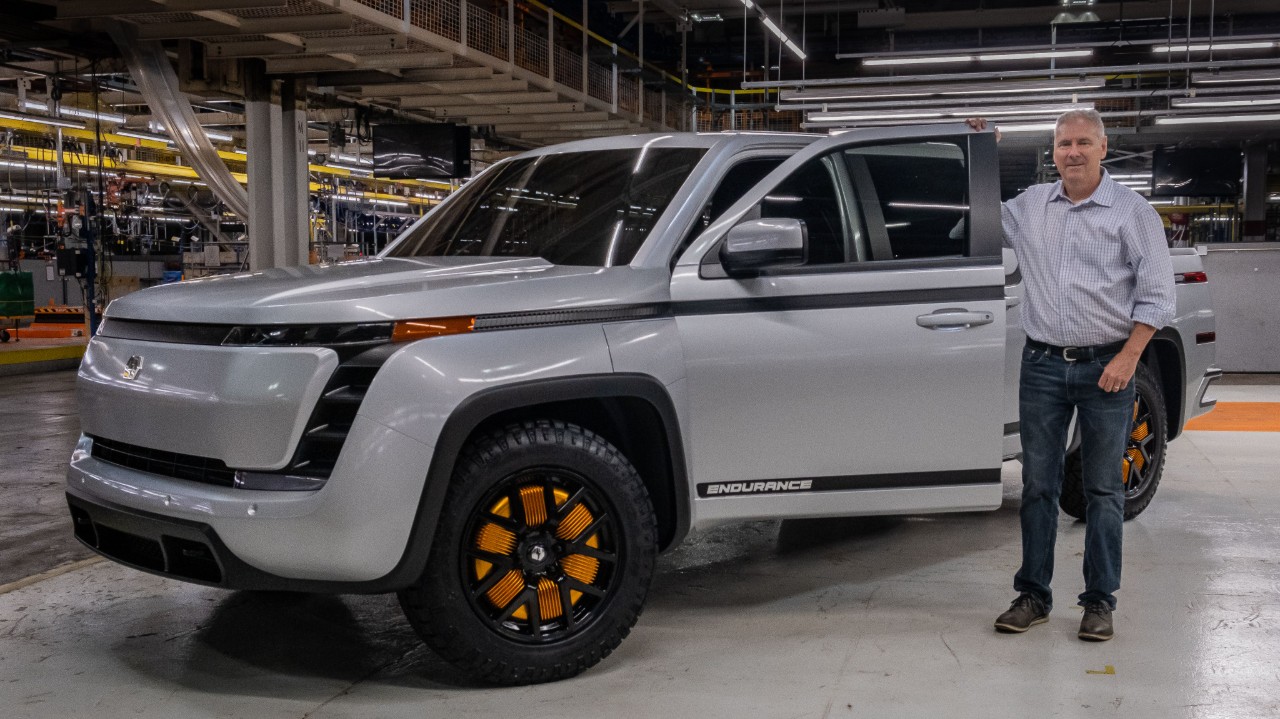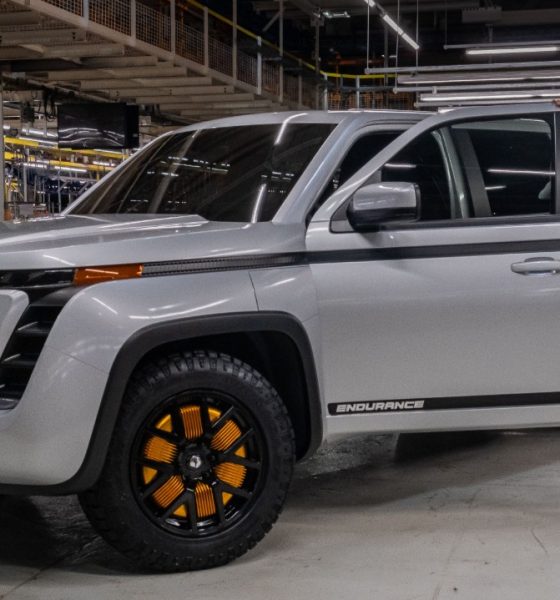

News
Lordstown Motors wants to join the electric pickup truck market too
Ohio-based Lordstown Motors unveiled its plans to join the growing electric pickup truck market with its first vehicle, dubbed “Endurance.”
The one-year-old startup based out of Lordstown, Ohio, will take over a former General Motors plant to build its first electric truck. CEO Steve Burns believes the Endurance has all the ingredients for success after the company has spent its time and money developing an all-electric truck that is capable of sports car-like acceleration and handling.
During the company’s presentation in Thursday, Burns talked about Lordstown’s process of designing the vehicle from the ground up, and not using a typical pickup engineering process to ensure the performance and efficiency of the truck was superior to its competitors.
“People are buried in their Ford [F]150. They have so much loyalty to it,” Burns said. “But, we are essentially coming in with a 75-mile per gallon pick up truck. In the end, cost is king, and we are the least expensive pickup truck.”
The Endurance has arrived. #RideWithLordstown pic.twitter.com/iQxzMZ5iHg
— Lordstown Motors (@LordstownMotors) June 25, 2020
The Endurance packs a self-proclaimed “revolutionary design” that features four in-wheel hub motors, making it the first-ever commercial vehicle to contain this specification. The use of the four motors independently driving each wheel gives the Endurance only four moving parts on the entire car, allowing the owner to spend less on maintenance and a “significantly lower total cost of ownership than traditional commercial vehicles.”
While functionality was essential to Burns, its aesthetic appearance was almost as crucial. “If the vehicle didn’t look good, it probably wouldn’t sell well. So we had to balance all of that in the design of it. It took a great team to do that.”
Lordstown says the Endurance will cost $52,500 and will give owners 250 miles of EV range, 600 horsepower, 7,500 pounds of towing capacity, and an 80 MPH top speed. The company didn’t provide any insight into its battery pack, its capacity, or where it will receive batteries from. However, GM and LG Chem are building a $2.3 billion joint venture battery cell plant in Lordstown, but it is unknown if this facility will supply the electric startup with packs for the Endurance.
As of right now, no electric truck is currently being manufactured or produced. However, 2021 seems to be heading toward a label of “The Year of the Electric Pickup.” With Rivian planning to build its R1T at the beginning of the year, the Tesla Cybertruck beginning production in a new facility at the tail end of the year, and Lordstown’s Endurance with a planned rollout in 2021 as well, there is plenty of competition in the sector.
Currently, gas-powered trucks are among the most popular vehicles in the United States. The Ford F-150 reigns supreme, just like it has for many years. However, with the electric vehicle movement continuing to grow and more consumers heading toward sustainable transportation, there is plenty of evidence to suggest that an array of competition in the E-pickup market will help the environmental cause.

Elon Musk
Starlink passes 9 million active customers just weeks after hitting 8 million
The milestone highlights the accelerating growth of Starlink, which has now been adding over 20,000 new users per day.

SpaceX’s Starlink satellite internet service has continued its rapid global expansion, surpassing 9 million active customers just weeks after crossing the 8 million mark.
The milestone highlights the accelerating growth of Starlink, which has now been adding over 20,000 new users per day.
9 million customers
In a post on X, SpaceX stated that Starlink now serves over 9 million active users across 155 countries, territories, and markets. The company reached 8 million customers in early November, meaning it added roughly 1 million subscribers in under seven weeks, or about 21,275 new users on average per day.
“Starlink is connecting more than 9M active customers with high-speed internet across 155 countries, territories, and many other markets,” Starlink wrote in a post on its official X account. SpaceX President Gwynne Shotwell also celebrated the milestone on X. “A huge thank you to all of our customers and congrats to the Starlink team for such an incredible product,” she wrote.
That growth rate reflects both rising demand for broadband in underserved regions and Starlink’s expanding satellite constellation, which now includes more than 9,000 low-Earth-orbit satellites designed to deliver high-speed, low-latency internet worldwide.
Starlink’s momentum
Starlink’s momentum has been building up. SpaceX reported 4.6 million Starlink customers in December 2024, followed by 7 million by August 2025, and 8 million customers in November. Independent data also suggests Starlink usage is rising sharply, with Cloudflare reporting that global web traffic from Starlink users more than doubled in 2025, as noted in an Insider report.
Starlink’s momentum is increasingly tied to SpaceX’s broader financial outlook. Elon Musk has said the satellite network is “by far” the company’s largest revenue driver, and reports suggest SpaceX may be positioning itself for an initial public offering as soon as next year, with valuations estimated as high as $1.5 trillion. Musk has also suggested in the past that Starlink could have its own IPO in the future.
News
NVIDIA Director of Robotics: Tesla FSD v14 is the first AI to pass the “Physical Turing Test”
After testing FSD v14, Fan stated that his experience with FSD felt magical at first, but it soon started to feel like a routine.

NVIDIA Director of Robotics Jim Fan has praised Tesla’s Full Self-Driving (Supervised) v14 as the first AI to pass what he described as a “Physical Turing Test.”
After testing FSD v14, Fan stated that his experience with FSD felt magical at first, but it soon started to feel like a routine. And just like smartphones today, removing it now would “actively hurt.”
Jim Fan’s hands-on FSD v14 impressions
Fan, a leading researcher in embodied AI who is currently solving Physical AI at NVIDIA and spearheading the company’s Project GR00T initiative, noted that he actually was late to the Tesla game. He was, however, one of the first to try out FSD v14.
“I was very late to own a Tesla but among the earliest to try out FSD v14. It’s perhaps the first time I experience an AI that passes the Physical Turing Test: after a long day at work, you press a button, lay back, and couldn’t tell if a neural net or a human drove you home,” Fan wrote in a post on X.
Fan added: “Despite knowing exactly how robot learning works, I still find it magical watching the steering wheel turn by itself. First it feels surreal, next it becomes routine. Then, like the smartphone, taking it away actively hurts. This is how humanity gets rewired and glued to god-like technologies.”
The Physical Turing Test
The original Turing Test was conceived by Alan Turing in 1950, and it was aimed at determining if a machine could exhibit behavior that is equivalent to or indistinguishable from a human. By focusing on text-based conversations, the original Turing Test set a high bar for natural language processing and machine learning.
This test has been passed by today’s large language models. However, the capability to converse in a humanlike manner is a completely different challenge from performing real-world problem-solving or physical interactions. Thus, Fan introduced the Physical Turing Test, which challenges AI systems to demonstrate intelligence through physical actions.
Based on Fan’s comments, Tesla has demonstrated these intelligent physical actions with FSD v14. Elon Musk agreed with the NVIDIA executive, stating in a post on X that with FSD v14, “you can sense the sentience maturing.” Musk also praised Tesla AI, calling it the best “real-world AI” today.
News
Tesla AI team burns the Christmas midnight oil by releasing FSD v14.2.2.1
The update was released just a day after FSD v14.2.2 started rolling out to customers.

Tesla is burning the midnight oil this Christmas, with the Tesla AI team quietly rolling out Full Self-Driving (Supervised) v14.2.2.1 just a day after FSD v14.2.2 started rolling out to customers.
Tesla owner shares insights on FSD v14.2.2.1
Longtime Tesla owner and FSD tester @BLKMDL3 shared some insights following several drives with FSD v14.2.2.1 in rainy Los Angeles conditions with standing water and faded lane lines. He reported zero steering hesitation or stutter, confident lane changes, and maneuvers executed with precision that evoked the performance of Tesla’s driverless Robotaxis in Austin.
Parking performance impressed, with most spots nailed perfectly, including tight, sharp turns, in single attempts without shaky steering. One minor offset happened only due to another vehicle that was parked over the line, which FSD accommodated by a few extra inches. In rain that typically erases road markings, FSD visualized lanes and turn lines better than humans, positioning itself flawlessly when entering new streets as well.
“Took it up a dark, wet, and twisty canyon road up and down the hill tonight and it went very well as to be expected. Stayed centered in the lane, kept speed well and gives a confidence inspiring steering feel where it handles these curvy roads better than the majority of human drivers,” the Tesla owner wrote in a post on X.
Tesla’s FSD v14.2.2 update
Just a day before FSD v14.2.2.1’s release, Tesla rolled out FSD v14.2.2, which was focused on smoother real-world performance, better obstacle awareness, and precise end-of-trip routing. According to the update’s release notes, FSD v14.2.2 upgrades the vision encoder neural network with higher resolution features, enhancing detection of emergency vehicles, road obstacles, and human gestures.
New Arrival Options also allowed users to select preferred drop-off styles, such as Parking Lot, Street, Driveway, Parking Garage, or Curbside, with the navigation pin automatically adjusting to the ideal spot. Other refinements include pulling over for emergency vehicles, real-time vision-based detours for blocked roads, improved gate and debris handling, and Speed Profiles for customized driving styles.








